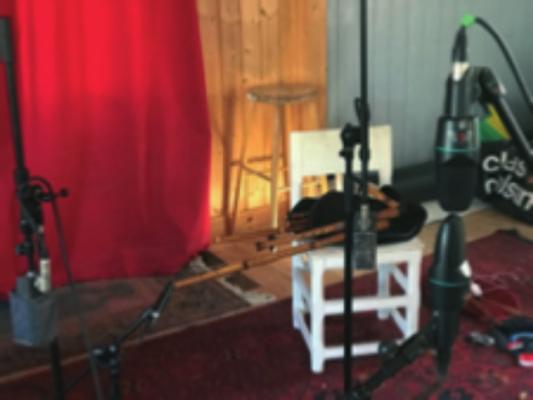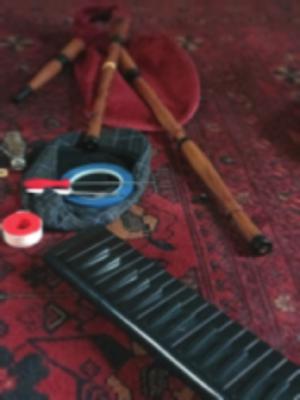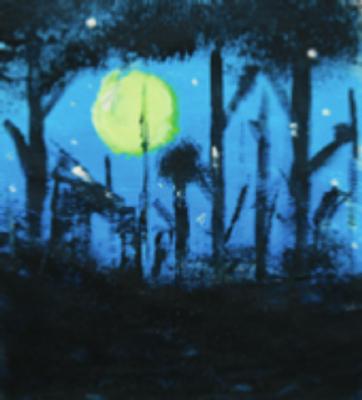The Bagpipe Society
The making of Wessmanlandsbitar
Or, how we learned to play the unplayable
In February 2022, me and Bruno Andersen released the album Wessmanlandsbitar on the record company Gammalthea. It is a collection of sixteen tunes which all originate from the county of Västmanland (which lies to the south of Dalarna and to the west of Stockholm) in Sweden. On the record I play Swedish bagpipes in different tunings and Bruno plays hurdy-gurdy. These two instruments are seldom played together in Swedish traditional music and the music from Västmanland has most certainly never been played this way before.
In this article I will describe the process of how we made the record, our thoughts on tune choices, arranging and recording. I will also share some thoughts on how to challenge yourself musically and some ideas on how to go beyond old habits.
Background
Bruno and I have played together since 2013 when we both were part of a larger drone music ensemble. This project did not last long so me and Bruno decided we should start playing as a duo instead. After numerous performances (mostly at Aifur, the local Viking bar in Stockholm) we felt that we wanted to share our music with a wider audience and decided to make a record.
Folk music from Västmanland
Västmanland is situated in-between several Swedish counties with strong folk musical traditions, Dalarna to the north, Uppland to the east and Närke and Värmland to the west. Common tune types are the so called Slängpolska (sometimes called Polonaise), Polska and Hampolska (Hamburgska).
We felt early on that we didn't want to make a record with tunes that people had already heard. I have my folk musical roots in Västmanland and felt it would be fun to do something with that tradition. I easily got Bruno on board because it's "so darn narrow and nerdy". The problem was that I also didn't want to record all the tunes from Västmanland that I already knew, because they were a bit over used in different contexts (some exceptions to this of course, only Sith deals in absolutes). It was time to find new tunes!
Västmanland's spelmansförbund (the fiddlers union of Västmanland) has previously published a collection of tunes from Västmanland called Folkmusik i Västmanland, but they are often referred to as Gula pärmarna (The yellow binders). This is a collection of transcripts from original notebooks that belonged to various fiddlers/folk musicians in Västmanland. In total, there are approximately 1,500 songs in the collection spread over two (very yellow) binders. As you can understand, it is a gold mine! The only problem is that Mr.
Fransson (who compiled them) was a bit careless, so many tunes are written down incorrectly, changed from major to minor and vice versa or otherwise corrupted. On the other hand, this leaves room for interpretation. Of the sixteen songs on the record, about five are from these binders. The rest of the songs on the album come from Svenska Låtar Västmanland and I have some after Josefina Paulsson and Carina Normansson.
Faithful to the source material**:** Throughout the process, we were careful to stay as close to the transcriptions as possible. As an example, we used transcribed double stops as a basis for the second part, as here in Näckens polska after Jan Erik Hammarberg (Who was an expert fiddler widely known for his skill):



Taking something old and making something new:

We recorded the album on two occasions during the summer of 2020. As our studio we used an old prayer house, the kind that the Swedish countryside is full of. Some days it was so hot that we had to have all the windows and doors open almost all the time (on some tunes, if you listen carefully, you can hear birds singing because of this). We used one ribbon mic each on the instruments and captured the room with two stereo pairs.
We worked very hard to arrange the tunes in a "non-droney" way. By that I mean that a lot of drone music is arranged in a generic way (this is not something bad, just not what we wanted to do), with the melody and parallel thirds, and possibly sixths if it's a little daring.
Use other instruments

When we rehearsed and arranged the songs, I almost always played Melodica and not bagpipes. I did this deliberately so as not to get stuck in old habits and patterns. Considering the limitations in range and tonality of Swedish bagpipes, it is easy to get stuck in only playing parallel second parts a third below the melody (which I do all the time if I improvise parts). When you play another instrument, you think a little differently and you often create different melodies and ideas than when you play something you are used to.
Dare to misuse your instrument
On some of the tunes on the record, both Bruno and I play in ways that you normally can't (or don't want to) play on the instruments. None of my bagpipes have keys to extend the tonal range, every note outside the normal range is overblown or played with half-covered holes. As an example, I sometimes play high and low sevenths in the same song (like Näckens polska, see example above), I play up to the sixth (or ninth depending on the root note) on some songs (See example above in Näckens polska) and on Franska polskan, I overblow all the way up to g on my g-pipe (a fourth above the highest note).

This note was found by a mistake when practicing Faderns favoritpolska which has the tone e above the chanter (G-chanter) range repeated several times. I noticed that the accent I put between the notes was the high g note.
The last tune we recorded was Polska efter Robert Landin, it's a tune I learned from Josefina Paulsson at least fifteen years ago (one of the exceptions to the new tune rule mentioned earlier). We had finished recording all the other tunes, but I felt I wanted to include it on the record because it's one of my absolute favourite tunes to play on the bagpipes. The only problem was that we had no good arrangement for it, just a generic second part in parallel thirds. We sat down and thought, and Bruno opened the lid of the Hurdy Gurdy and started fiddling with the leaves and playing double (actually triple) stops, we immediately felt that we needed use that in some way!
I sat down at an old out-of-tune piano and began to think of chords that could work over the melody. The story goes that I had previously geeked out on Brad Fiedel's music for the movie Terminator (if you haven’t heard it, you should check it out, very good stuff!) and thought that a similar harmony could probably work quite well. Here is an excerpt from the first part of the tunes Hurdy Gurdy part:

This was something none of us had heard before. Taking something old and making something new!
Closing thoughts
We are very proud of the result and pleased with the way the record has been received by the drone music community. If you should take anything with you from this text, just remember this:
-
Dare to challenge your instrumentś limits, you might find something you didn’t expect.
-
You are in charge of your instrument and not the other way around. Just a few months before we recorded this album. I thought some of the tunes we had selected and decided to record was practically unplayable, I was proven wrong (by me).
-
When learning and arranging music, try using other instruments than the one you are arranging for. It is a sure way to move beyond old habits.

Biography
Folke is a multiinstrumentalist playing a variety of instruments such as guitars, 5 string banjo, flutes and bagpipes. He was appointed Riksspelman on Swedish bagpipe in 2013. In July 2022 he won the competition for solo bagpipe at Le Son Continu. Folke plays Swedish bagpipes in the keys of A, G, F and D made by Max Persson, all of them with carbon fibre reeds.
Bruno is a former prog metal drummer/classical schooled percussionist who switched to fulltime Hurdy-gurdyist.
He has been playing in all manners of ensembles varying from pure noise, to circus music and traditional folk music. Nowadays he is working as a sailor in the Stockholm archipelago. Bruno plays an alto hurdy-gurdy with extended range (down to Bb/F) made by Wolfgang Weichselbaumer.
If you would like to listen to the record, it is available on all major streaming platforms, such as Spotify, Apple Music, Amazon Music, YouTube etc. If you would like a physical copy of it, you can reach out to us through our Facebook page:
https://www.facebook.com/bordunduo
- Data Processing Notice (GDPR)
-
@BagpipeSociety on X (formally known as Twitter)
-
TheBagpipeSociety on Instagram
-
 BagpipeSociety on Facebook
BagpipeSociety on Facebook
Something wrong or missing from this page? Let us know!
